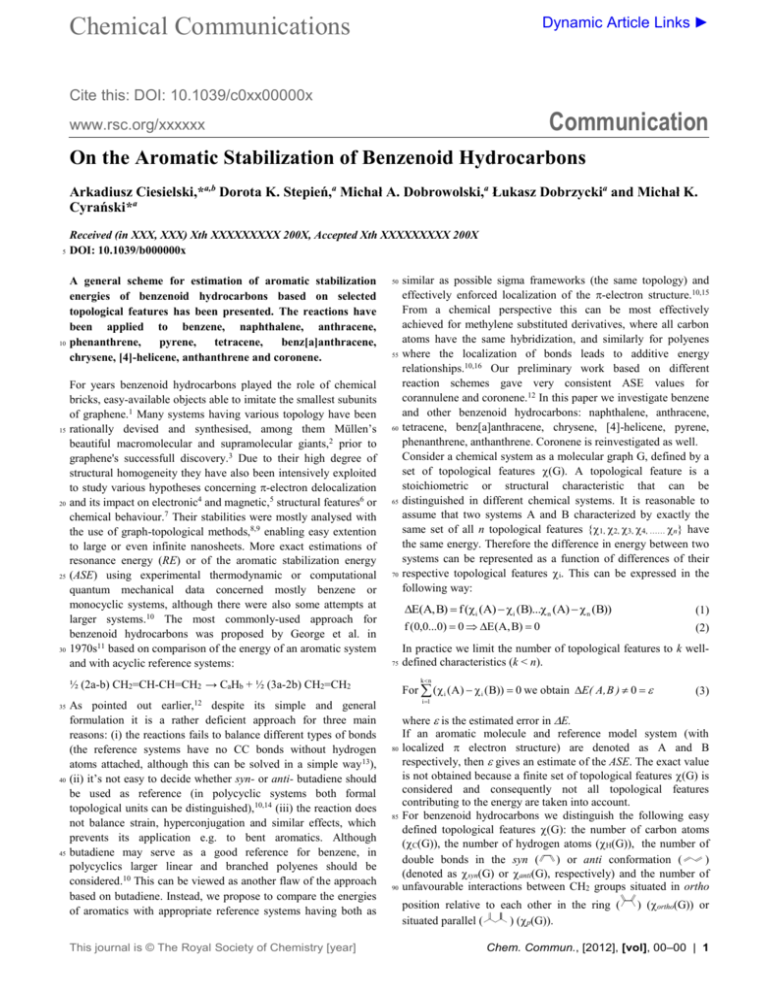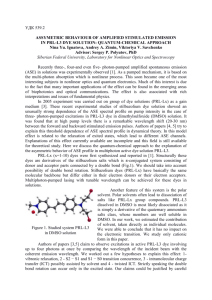RSC Communication Template (Version 3.2)
advertisement

Dynamic Article Links ►
Chemical Communications
Cite this: DOI: 10.1039/c0xx00000x
Communication
www.rsc.org/xxxxxx
On the Aromatic Stabilization of Benzenoid Hydrocarbons
Arkadiusz Ciesielski,*a,b Dorota K. Stepień,a Michał A. Dobrowolski,a Łukasz Dobrzyckia and Michał K.
Cyrański*a
5
10
15
20
25
30
Received (in XXX, XXX) Xth XXXXXXXXX 200X, Accepted Xth XXXXXXXXX 200X
DOI: 10.1039/b000000x
A general scheme for estimation of aromatic stabilization
energies of benzenoid hydrocarbons based on selected
topological features has been presented. The reactions have
been applied to benzene, naphthalene, anthracene,
phenanthrene,
pyrene,
tetracene,
benz[a]anthracene,
chrysene, [4]-helicene, anthanthrene and coronene.
For years benzenoid hydrocarbons played the role of chemical
bricks, easy-available objects able to imitate the smallest subunits
of graphene.1 Many systems having various topology have been
rationally devised and synthesised, among them Müllen’s
beautiful macromolecular and supramolecular giants,2 prior to
graphene's successfull discovery.3 Due to their high degree of
structural homogeneity they have also been intensively exploited
to study various hypotheses concerning -electron delocalization
and its impact on electronic4 and magnetic,5 structural features6 or
chemical behaviour.7 Their stabilities were mostly analysed with
the use of graph-topological methods,8,9 enabling easy extention
to large or even infinite nanosheets. More exact estimations of
resonance energy (RE) or of the aromatic stabilization energy
(ASE) using experimental thermodynamic or computational
quantum mechanical data concerned mostly benzene or
monocyclic systems, although there were also some attempts at
larger systems.10 The most commonly-used approach for
benzenoid hydrocarbons was proposed by George et al. in
1970s11 based on comparison of the energy of an aromatic system
and with acyclic reference systems:
50
55
60
65
70
75
40
45
As pointed out earlier,12 despite its simple and general
formulation it is a rather deficient approach for three main
reasons: (i) the reactions fails to balance different types of bonds
(the reference systems have no CC bonds without hydrogen
atoms attached, although this can be solved in a simple way 13),
(ii) it’s not easy to decide whether syn- or anti- butadiene should
be used as reference (in polycyclic systems both formal
topological units can be distinguished),10,14 (iii) the reaction does
not balance strain, hyperconjugation and similar effects, which
prevents its application e.g. to bent aromatics. Although
butadiene may serve as a good reference for benzene, in
polycyclics larger linear and branched polyenes should be
considered.10 This can be viewed as another flaw of the approach
based on butadiene. Instead, we propose to compare the energies
of aromatics with appropriate reference systems having both as
This journal is © The Royal Society of Chemistry [year]
E(A, B) f (i (A) i (B)...n (A) n (B))
(1)
f (0,0...0) 0 E(A, B) 0
(2)
In practice we limit the number of topological features to k welldefined characteristics (k < n).
k n
½ (2a-b) CH2=CH-CH=CH2 → CaHb + ½ (3a-2b) CH2=CH2
35
similar as possible sigma frameworks (the same topology) and
effectively enforced localization of the -electron structure.10,15
From a chemical perspective this can be most effectively
achieved for methylene substituted derivatives, where all carbon
atoms have the same hybridization, and similarly for polyenes
where the localization of bonds leads to additive energy
relationships.10,16 Our preliminary work based on different
reaction schemes gave very consistent ASE values for
corannulene and coronene.12 In this paper we investigate benzene
and other benzenoid hydrocarbons: naphthalene, anthracene,
tetracene, benz[a]anthracene, chrysene, [4]-helicene, pyrene,
phenanthrene, anthanthrene. Coronene is reinvestigated as well.
Consider a chemical system as a molecular graph G, defined by a
set of topological features (G). A topological feature is a
stoichiometric or structural characteristic that can be
distinguished in different chemical systems. It is reasonable to
assume that two systems A and B characterized by exactly the
same set of all n topological features {1, 2, 3, 4, …… n} have
the same energy. Therefore the difference in energy between two
systems can be represented as a function of differences of their
respective topological features i. This can be expressed in the
following way:
For ( i (A) i (B)) 0 we obtain E( A, B ) 0
(3)
i 1
80
85
90
where is the estimated error in E.
If an aromatic molecule and reference model system (with
localized electron structure) are denoted as A and B
respectively, then gives an estimate of the ASE. The exact value
is not obtained because a finite set of topological features (G) is
considered and consequently not all topological features
contributing to the energy are taken into account.
For benzenoid hydrocarbons we distinguish the following easy
defined topological features (G): the number of carbon atoms
(C(G)), the number of hydrogen atoms (H(G)), the number of
double bonds in the syn ( ) or anti conformation (
)
(denoted as syn(G) or anti(G), respectively) and the number of
unfavourable interactions between CH2 groups situated in ortho
position relative to each other in the ring (
situated parallel (
) (p(G)).
) (ortho(G)) or
Chem. Commun., [2012], [vol], 00–00 | 1
Most comprehensively the procedure can be presented for
benzene. In this case we have only four methylene substituted
reference systems, that lead to -electron structure localization.
Their structures and topological features are given below.
c1
5
C = H
syn
anti
orhto
8
0
4
0
8
2
2
1
10
3
2
3
12
6
0
6
6
3
0
0
45
+ c2
(R1)
+ c3
(R2)
(R3)
(R4)
(B)
10
Since the number of topological features on both sides of reaction
must match, the ci coefficients can be found by solving the
following set of linear equations:
c1CH (R1)
c1syn (R1)
c1anti (R1)
c1ortho (R1)
15
20
+ c2CH (R2)
+ c2syn (R2)
+ c2anti (R2)
+ c2ortho (R2)
+ c3CH (R3)
+ c3syn (R3)
+ c3anti (R3)
+ c3ortho (R3)
+ c4CH (R4)
+ c4syn (R4)
+ c4anti (R4)
+ c4ortho (R4)
= CH (B)
= syn (B)
= anti (B)
= ortho (B)
55
(5)
Hence:
F( t ) c ( t )
i 1
30
(6)
Where EA is the energy of (delocalized) benzene. The EB (and
therefore ASE) has the estimated error (B), which is smaller if a
larger number of topological features is taken into account. It is
clear that B depends also on the reaction coefficients ci(t). If they
are bigger, the error is also bigger. The minimization of the
function
k
2
i
60
65
(7)
within the least square procedure leads to t = - 1/6 (see the ESI
and Figure 1). Thus the estimated ASE value for benzene is 29.1
kcal/mol, perfectly in line with other reliable estimations.10
35
Figure 1. The F(t) and F(t,u) functions for benzene and pyrene
40
The procedure for polycyclic systems is slightly more
complicated because more reference compounds may be
considered and hence more reactions can be constructed. An
example for pyrene is shown below:
2 | Journal Name, [year], [vol], 00–00
In this case a solution based on set of linear equations,
constructed in a similar way as for benzene, leads to the
stoichiometric coefficients ci(t,u),
c1 3t u 8
c2 6t u 14 c3 t c4 u 1 and c5 u ,
3
3
26 0.703 (see Figure 1 and the ESI for details), which results
37
in a value of 48.6 kcal/mol for the ASE of pyrene. The other
values based on different reactions are very consistent with each
other.17 They are given in Table 1, together with the reaction
coefficients. The resulting ASE is 49 kcal/mol with the standard
deviation based on 15 reactions of only 1.6 kcal/mol!
-0.550
-2.300
-2.000
-0.833
-0.667
-0.320
-2.150
-0.200
-1.538
-1.308
-0.833
-0.667
-2.300
-2.000
-0.667
i 1
25
→
ASE
k
k
ASE E B E A c i ( t )E R i E A
i
1
+ c5
Table 1. Coefficients ci and the ASE values [kcal/mol] for pyrene.
(4)
Since two CXHY isomers having the same number of bonds
have (syn + anti) constant, a set of linearly dependent equations
is obtained. The reaction coefficients are c1=(t-1), c2=3, c3=(-2t-1)
and c4=t. The energy of the localized system (B) can be obtained
from the following equation:
E B c i ( t )E R i
+ c4
111
50
→
+ c4
+ c3
which depend on two parameters t and u. Finding the minimum
of
the
corresponding
two-dimentional
function
(F(t,u)= 1/9(54t2-216t+20u2+62u-18tu+269)) by a least-squares
procedure leads to values of tmin= 209 1.883 and umin =
To estimate the energy of localized (reference structure), EB, the
following homodesmotic reaction can be formulated:
c1
+ c2
0.667 1.883
0
0
0
-0.297
0
-0.703
4.300
0
-1.100 1.100
0
-1.000
0
0
4.000
0
-1.000 1.000
0
0
0
-1.000
2.833
0
-1.833
0
1.833 -1.000
0
0
2.667
0
-1.667
0
1.667
0
0
-1.000
2.320
0
-1.760
0
0
-1.000 1.760
0
4.150
0
0
0
0
0.550
0
-1.550
2.200
0
-1.600
0
0
0
1.600 -1.000
3.538
0
0
-1.692 1.692 -1.000
0
0
3.308
0
0
-1.538 1.538
0
0
-1.000
2.833
0
0
-1.833
0
-1.000 1.833
0
2.667
0
0
-1.667
0
0
1.667 -1.000
4.300
0
0
0
-1.100 -1.000 1.100
0
4.000
0
0
0
-1.000
0
1.000 -1.000
0.667 2.000
0
0
0
-1.000
0
0
1
1
1
1
1
1
1
1
1
1
1
1
1
1
1
48.6
50.0
48.8
50.3
49.1
52.5
46.5
51.1
47.1
46.2
49.4
48.3
49.5
48.4
49.3
In the case of polycyclic systems, another complication comes
from the fact that they are represented by different canonical
structures. In principle they are characterized by different sets of
topological features syn and anti, which although unlikely for
benzene, result in sets of different aromatic stabilization energies.
In fact, slightly modified reactions are obtained for other
canonical representations, but all of them are again very
consistent (see ESI and Table 3). In this context it is reasonable to
assume that the ASE is the largest possible stabilization of an
aromatic molecule compared to a model system with localized electron structure.
70
Table 2. The minimal, maximal values of ASE [kcal/mol] and
their standard deviations based on 15 reactions18 (see the ESI).
Benzene*
Naphthalene
Anthracene
Phenanthrene
Pyrene
Tetracene
Benz[a]anthracene
Chrysene
[4]-helicene
Antanthrene
Coronene
*
based on one reaction
75
ASEmin
29.1
33.4
36.2
41.7
40.8
34.8
44.0
48.3
44.8
39.4
45.8
s.d. ASEmin
0.7
1.0
2.9
1.1
2.1
3.2
2.1
1.6
2.4
2.3
ASEmax
29.1
39.4
42.0
51.4
49.0
39.2
54.5
56.4
51.9
46.2
58.1
s.d. ASEmax
0.8
1.9
2.7
1.7
2.2
0.9
2.7
1.9
2.3
1.9
Table 2 presents minimal and maximal values of ASE calculated
for the benzenoid hydrocarbons: benzene, naphthalene,
anthracene, phenanthrene, pyrene, tetracene, benz[a]anthracene,
chrysene, [4]-helicene, anthanthrene and coronene. They are
This journal is © The Royal Society of Chemistry [year]
5
10
15
20
25
30
35
40
45
50
mean values based on 15 reaction schemes (except for benzene).
Their standard deviations clearly indicate that the procedure
described in this paper is very consistent. What’s important is that
the stabilization refers to model systems that represent a limiting
case of chemically achievable localization of -bonds. It should
also be pointed out that the procedure enables exact reproduction
of their energies (within c.a. 1-2 kcal/mol error), proving that the
topological features are perfectly additive for the reference
compounds (see Table 4S ESI).
Interestingly, in all benzenoid systems the highest value of
stabilization is always observed for the so-called Fries canonical
structure,19 and the lowest value for the anti-Fries structure. The
former is the structure having the maximal number of -electron
sextets (also maximal number of syn topological units), whereas
the latter is characterized by the maximal number of anti
topological units. A plot of the calculated ASEmax per -electron
versus the number of -electrons (Figure 2) reveals clear
lowering of stabilization energy in the series of acenes
(correlation coefficient for the linear regression is R=0.999),
which is in line with chemical stability of these systems 20 and
explains well why breaking the electron delocalization in central
rings e.g. by addition reaction is easy affordable. In line with
chemical expectations the angular system (phenanthrene) is more
stable than the linear one (anthracene),21 while the relative
aromatic stabilization of coronene is lower than the value for
pyrene. In the family of chrysene is stabilized most (ASE=56.4
kcal/mol), whereas tetracene is stabilized least (ASE=39.2
kcal/mol). The sequence of compounds reflects the order of
relative stabilities in this series perfectly. The sequence of
compounds in four fused six-membered rings group match
perfectly the order of their overall stabilities,22 with chrysene and
tetracene stabilized most (ASE=56.4 kcal/mol) and least
(ASE=39.2 kcal/mol), respectively. This is very important
finding, as suggests that the differences in total energies between
the isomers are (almost) solely due to different aromatic
stabilization while other effects (like e.g. strain) have a minor
differentiation role and influence all systems to similar extent.
Figure 2. Dependence of ASE/N versus the number of
-electrons N.
Summing up: a general scheme for estimation of aromatic
stabilization energies of benzenoid hydrocarbons has been
presented. This approach can easily be extended to nonbenzenoid systems (in fact this kind of approach has already been
applied for deriving the ASE for corannulene)12 or for
heterocyclic molecules. The reference compounds have similar
sigma framework as the aromatics and represent model systems,
with most efficient (from a chemical perspective) localized electron structures. The estimated aromatic stabilization energies
based on different reaction schemes lead to very consistent values
provided that the reaction coefficients are optimally derived. The
This journal is © The Royal Society of Chemistry [year]
55
60
65
maximal ASE values were always obtained for the Fries-type
structure. The lowering of stability depends on topology and is
accompanied by an increase of the size of a molecule.
The systems used for ASE estimations were fully optimized at
B3LYP/6-311G** level of theory (see the notes for details).
The paper is dedicated to Prof. Paul von Ragué Schleyer in
recognition of his outstanding contribution to the field of
aromaticity. The ICM (Warsaw) is gratefully acknowledged for
computational facilities. We thank Grzegorz Stępień for his help
in preparing an early draft of paper. Finally we thank Dr. Sian
Howard for proof-reading the manuscript.
Notes and references
a
70
Faculty of Chemistry, University of Warsaw, Pasteura 1, 02-093
Warsaw, Poland. Fax: 48 22 8222892; Tel: 48 228220211 ext.
360; E-mail: chamis@chem.uw.edu.pl (M. K. Cyrański).
b Institute of Biochemistry and Biophysics, Polish Academy of
Science, Pawińskiego 5a, 02-106 Warsaw, Poland
†
75
80
85
Electronic Supplementary Information (ESI) available: Point groups,
absolute electronic energies and Cartesian coordinates calculated at
B3LYP/6-311G** for benzene and naphthalene, anthracene, tetracene,
phenanthrene, benz[a]anthracene, chrysene, [4]-helicene, pyrene,
anthanthrene, coronene and its derivatives. The coefficients of the
reactions used for ASE calculations. The sets of homodesmotic reaction
coefficients ci showing additivity in the energy of reference compounds.
Full citation of Ref. [23]. See DOI: 10.1039/b000000x/
‡ All systems were optimized at the B3LYP/6-311G** DFT level of
theory using the Gaussian 03 program.23 The calculated geometries of
benzene and naphthalene, anthracene, tetracene, phenanthrene, pyrene,
benz[a]anthracene, chrysene, [4]-helicene, anthanthrene, coronene and
their derivatives were true minima on potential energy surface with no
imaginary vibrational frequencies. In the above mentioned cases zero
point energy (ZPE) corrections were included.
1 H. Hopf, Classics in Hydrocarbon Chemistry: Syntheses, Concepts,
Perspectives; Wiley – VCH: Weinheim, Germany, 2000.
2 For review see M. D. Watson, A. Fechtenkötter and K. Müllen, Chem.
Rev., 2001, 101, 1267.
3 K. S. Novoselov, A. K. Geim, S. V. Morozov, D. Jiang, Y. Zhang, S.
V. Dubonos, I. V. Grigorieva and A. A. Firsov, Science, 2004, 306,
666-669.
4 e.g. S. T. Howard and T. M. Krygowski, Can. J. Chem. 1997, 75, 1174;
G. Portella, J. Poater and M. Solà, J. Phys. Org. Chem., 2005, 18, 785;
M. Palusiak and T. M. Krygowski, Chemistry Eur J., 2007, 13, 7996.
5 e.g. E. Steiner, P. W. Fowler, A. Soncini and L. W. Jenneskens,
Faraday Discussions, 2007, 135, 309.
6 T. M. Krygowski, M. Cyrański, A. Ciesielski, B. Świrska and P.
Leszczyński, J. Chem. Inf. Comput. Sci. 1996, 36, 1135.
7 S . Panigrahi, A. Bhattacharya, D. Bandyopadhyay, S. J. Grabowski, D.
Bhattacharyya and S. Banerjee, J. Phys. Chem. C., 2011, 115, 14819.
8 I. Gutman and S. J. Cyvin, Introduction to the Theory of Benzenoid
Hydrocarbons, Springer-Verlag: New York, 1989 and citations therein.
9 R Chauvin, C. Lepetit, P. W. Fowler and J. P. Malrieu, Phys. Chem.
Chem. Phys., 2010, 12, 5295.
10 M. K. Cyrański, Chem. Rev., 2005, 105, 3773 and citations therein.
11 P. George, M. Trachtman, C. W. Bock and A. M. Brett, Theor. Chim.
Acta, 1975, 38, 121.
12 M. A. Dobrowolski, A. Ciesielski and M. K. Cyrański, Phys. Chem.
Chem. Phys., 2011, 13, 20557.
13 P. George, M. Trachtman, A. M. Brett and C. W. Bock, J. Chem. Soc.,
Perkin Trans. 2, 1977, 1036.
14 The energy difference between two conformers is c.a. 3 kcal/mol, see
also P. v. R. Schleyer and F. Pühlhofer, Org. Lett., 2002, 4, 2873.
15 M. K. Cyrański, S. T. Howard and M. L. Chodkiewicz, Chem.
Commun., 2004, 2458.
16 M. J. S. Dewar and C. de Llano, J. Am. Chem. Soc., 1969, 91, 789.
17 The parameterization of the equations arises from reduced number of
topological features (having easy-defined physical meaning) in respect
to the number of methylene derivatives. Construction of a set of
Chem. Commun., [2012], [vol], 00–00 | 3
equations dependent on parameter allows us minimization the energy
estimation error of the reference structure. Note also that the reactions
can be potentially linearly combined in an infinite number of ways,
thus, generating new reactions leading to less consistent values. The
optimization procedure leads to the coefficients that prevent error
multiplication.
18 Note that more reactions can be formulated for each case. The
selection was made based on smallest reaction coefficients, as they
involve the smallest final energy estimation error.
19 K. Fries, Justus Liebigs Ann. Chem. 1927, 454, 121.
20 M. K. Cyrański, B. T. Stępień and T. M. Krygowski, Tetrahedron,
2000, 56, 9663.
21 J. Poater, R. Visser, M. Solà and F. M. Bickelhaupt, J. Org. Chem.,
2007, 72, 1134.
22 T. M. Krygowski and M. K. Cyrański, Chem. Rev. 2001, 101, 1385.
23 M. J. Frisch et al., Gaussian, Inc.,Wallingford CT, 2004.
4 | Journal Name, [year], [vol], 00–00
This journal is © The Royal Society of Chemistry [year]







